#overall this is just a silly sort of thing that i churned out and published do with it what you will
Explore tagged Tumblr posts
Text
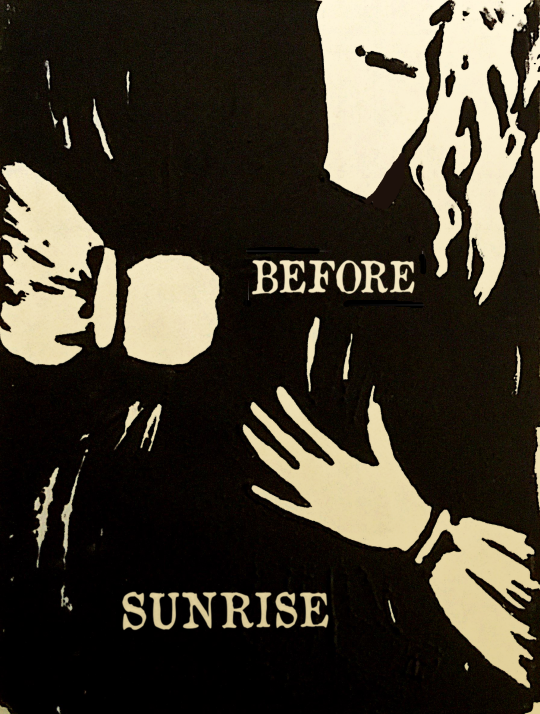
Before Sunrise (وإنتَ بترجع لأيقوناتَك، وأنا للفراغ) • A Hornblower fic by quatregats
You look at me, your eyes shining intensely with sudden emotion, and for a moment every mask has fallen away. There’s something sobering about it, knowing that you’ve given me this secret, that you’ve let me see you vulnerable and unguarded, and I promise to myself that I’ll never tell another soul. Your dark curls frame your face, and you are so lovely and real that it hurts. The weight of the world has been lifted from your shoulders, and I wish it could stay that way forever.
In the Kingston darkness, Hornblower might just allow himself a few moments in Bush's arms.
You can read it here!
#sorry guys this is perhaps an insane thing to write for the hornblower series#but i was listening to kalaam and i got carried away :’)#you should really listen to the song before you read the fic#because this is basically a three-way conversation between the song the fic and canon#the perspective kind of makes it hard not to write as poem-adjacent and bush isn’t much for poems so pardon the discrepancy there#overall this is just a silly sort of thing that i churned out and published do with it what you will#the title is so extremely cheesy i’m sorry ://#the lyric in the title goes much harder but alas it’s in arabic#also once again made a fun little block print! this one was much less time consuming though luckily#perce rambles#scribblings & such#<- thought that perhaps i should make a tag for my original works (writing/drawing)#hornblower#i really don't think this is comprehensible the only person who seems to have gotten it was also a kalaam fan but oh well#percy yells at cecil scott
1 note
·
View note
Text
Abandoned WIP
This is a melancholy little entry that I stopped working on back in 2015, apparently, since Mary and John’s daughter is an “Amelia” rather than a “Rosie,” and Mary’s real name is “Angela” not “Rosamund” During the period in which I was writing it they announced, filmed, and released the film “Mr. Holmes” which deals with some similar subjects but which I did NOT rip off. I ripped off a Mitchell and Webb sketch:)
Age, eventually, makes mockeries of all of us. When I was in my sixties and seventies, I discovered that I did in fact have a heart. And a pancreas. And many joints, none of which seemed to want to work together properly anymore. And several other failing body parts that required me to take a dozen pills every single day of my life.
None of this happened to Sherlock. He remained more or less exactly as he’d always been, just craggier. He kept his hair, and when it changed color it started in elegant wings over his temples then became a flattering overall silver. Meanwhile I discovered that even once I gave up on blonde, I would have to keep coloring my hair, since it was an unattractive yellowish grey when left to its own devices.
Despite my array of minor ailments, our life together was… good. We split our time between the Sussex downs, where his bees were, and London, where our grandchildren were. He took cases, but only the most interesting ones. I wrote my novels, but only every three years, instead of the annual volumes I’d churned out in my prime. Sherlock wrote a practical handbook on beekeeping and was furious that nobody wished to buy it.
It was a snowy winter afternoon in Baker Street, and he’d just come in from the cold. He was flushed and excited to tell me all about what he’d been up to since he’d been gone for a week: a commonplace-seeming garroting that had led to the discovery of an active human-sacrifice cult with multiple sites across Europe. I vaguely considered putting it into a story but decided it was so wildly implausible that even my extremely patient readers wouldn’t believe it.
“Oh, you should have seen it, Mary!” he exclaimed, “There I was, tied to the altar below the statue of Czernobog, and the priest was saying the chant and holding the rope over my head, when all at once the door burst open and-“
He paused, then, and said, “Oh, hell. What’s his name? The detective inspector? Amelia’s boss? Black, muscular, gay?”
“Ted Gregson.”
“Yes. Right. Him.”
He didn’t continue on, but flung himself into chair and stared into the fireplace. I prodded, “So then what happened?”
“I believe something’s gone wrong with my mind, Mary.”
I rolled my eyes at that. For someone who was always as healthy as a horse he was a terrible hypochondriac.
“You had a senior moment. Anyway you never used to remember Greg’s name either… you may have some sort of block for DIs.”
“No. This is something different. And it’s been going on for a while.”
Sherlock was right. He mostly was. Like a lot of intelligent people, he’d been able to compensate for the earliest stages, but he was right. After that, the progression seemed terribly fast. We spent several months in a haze of scans and therapy, and he accumulated enough prescription bottles to rival my own collection. Some of them were highly experimental and provided by his brother’s network of mysterious scientists. None of them really seemed to do much.
Amelia, being the dear that she is, volunteered to take us in when it all started getting too much for me to handle by myself. But she had three young children and a husband to look after, a hugely busy career with the Met, plus far too many stairs for me to manage every day. Therefore I sold the house at Baker Street for an obscene amount of money to a city stockbroker, and we moved out to the downs for what I knew would be the last time.
I’ve spent my life moving on and leaving things behind me. I’d dropped the original version of myself with no real regrets. I’d quit my first two careers, both of which I’d been proud of and enjoyed. I’d managed to get through the death of a husband who I had loved so much that even thirty years later it still hurt to think of him. So it’s silly how many tears I shed over that dingy Georgian money pit.
But the cash I got for the place was very helpful. Despite the continuing success of the Jim Winston novels and the fact that Sherlock had softened up on taking dull cases for money as he aged, we weren’t exactly rich. Then, too, we had new expenses. I had to hire a nice young woman to help me look after the house, and a large young man to keep an eye on Sherlock in the evenings, since he tended to want to wander after dark.
Then I had to hire another nice young woman because Sherlock had deduced that the original one was unfaithful to her husband, and had of course done it to her face. Then another large young man since Sherlock, who took a while to experience any of the physical debility that comes with Alzheimer’s, got confused and shoulder-threw the first one across the lounge one evening. At a certain point I arranged for a local hippie couple to come by and look after the bees in exchange for the honey.
We carried on for a few years. He had his good days and his bad ones. On his good days he’d still consult, by email, since he had a rock-hard certainty that England couldn’t get by without him. I published “The Mountain of Fear,” which sold as well as any of my books but as always was savaged by the critics for popularist dreck.
I started work on my next novel and got about a quarter of the way through it. Then one day I realized that it was likely that it would be the last one I ever had time to write, and that after it was done, there would be no more Jim Winston stories. I could face not writing it, but I couldn’t face a world where John, even a fictionalized and imaginary John, wasn’t around, and so I put the MS in a drawer in my desk and turned the key. “Caught in transition from imagination to life” was the best epitaph I could have written for him, with my limited abilities.
We had fewer and fewer good days.
On a brilliant indian summer day, I went to London to have a new and complicated type of bone scan that couldn’t be done locally. This was mostly uneventful, although we incidentally discovered that I had finally shrunk to the point where I was less than five feet tall. The nurse said the radiologist would look over the films and be in touch in the next few weeks. I took Amelia to lunch and we talked about the grandchildren, mostly, and she promised to bring them out for a visit at the weekend. Then I took the train back home- I still drove, but didn’t care to do it in the city any more.
When I got back from the station, there was a long black town car parked on the gravel drive in front of our house. The driver, a lovely young woman and obviously a Secret Service agent, was leaning on the hood smoking a cigarette. She nodded politely to me as I passed by. I therefore was not surprised to see Sherlock’s brother sitting in the kitchen, drinking tea. He shared the Holmes tendency for turning up where he wasn’t expected.
Or wanted.
Like his brother, he was well-preserved physically, though in the case of Mycroft the adjective “mummified” always seemed more appropriate. He had to be nearly ninety but his eyes were as bright and judgmental as they ever had been. He nodded to me as Vithnya, the second housekeeper, helped me out of my coat.
“Mycroft.”
“Mary.”
We weren’t ever particularly friendly. He’d never trusted me, and had verbally disapproved of my relationship with Sherlock until it was so well-established that it had become a pointless gesture on his part. For my part, I despised the constant needling that was his preferred method of interaction with his younger brother. To the best of my knowledge he and Sherlock hadn’t met in person for nearly three years.
Even with all that, it was oddly relaxing to talk to him. We were both such skilled and professional liars that we never bothered trying it out with one another.
“How’s he done since I was out?” I asked Vithnya.
“Pretty well. He had a nice chat with Mr. Holmes – with Mr. Mycroft Holmes, that is - and now he’s out with his bees. But he was a little agitated this morning. He kept walking around looking for someone called Angela.”
I could feel Mycroft’s eyes boring in to me over the rim of his teacup. I smiled at the girl and said, “He was looking for me. It’s an old joke we used to have.”
She giggled, and I realized abruptly that she was relieved, that she’d worried I’d be hurt that my husband, in his confusion, wanted to see another woman. This was a thought that was so ridiculous on so many levels that I could have giggled myself.
Vithnya grinned, white teeth in her red lips, and said, “I don’t know about that. This Angela sounds like a most desperate character!”
“I was quite the firecracker when I was younger, my girl. Can you keep an eye on him while I chat with Mycroft, please?”
She poured me a cup of tea of my own and went off to do just that.
Mycroft said, “You don’t seem at all nervous of discovery now that Sherlock has lost what - minimal filters - he ever had.”
“I’m not.”
“No statute of limitations on murder.”
I rolled my eyes at him. He was the one, after all, who had replaced my rather half-assed false identity with something that could stand up to any scrutiny.
“She won’t think about it for more than thirty seconds after leaving this room. I am a little old lady. In the mind of a twenty-two year old, not only am I obviously harmless now but it is inconceivable I ever would have been otherwise. You ought to consider hiring some of us on at MI-6. We’re practically invisible.”
“Perhaps I ought.”
I took a biscuit, damn my blood sugar, and dunked it into my tea.
“Did you and Sherlock have a nice chat?” I asked.
He didn’t answer right away.
“We did,” he said, eventually, “For seventy-eight minutes. Not once in that period did he recognize me. I could tell he was making his best deductions. Sometimes he thought I was John Watson. Sometimes Greg Lestrade, sometimes Victor Trevor. I didn’t realize-”
“Didn’t realize what?”
“That he had become so debilitated. That he was so far gone.”
I sighed.
“He’s dying, Mycroft. What did you think it would be like?”
He took another biscuit from the packet on the table and put it into his mouth. Chewed.
“I never thought that he would be the first to go. I always assumed that I wouldn’t be the one left standing. When he’s gone-”
He trailed off. But I could read his thoughts as clearly as if they’d been my own. When Sherlock was gone there would be no one left with the same sort of mind that Mycroft had… except the departure had already happened, and he’d missed it.
I had some sympathetic pangs – for Mycroft Holmes, of all people – and I said, “He generally perks up a bit in the evenings. I’m happy to put you up, if you’d like. Perhaps you could… try again?”
The British Government responded as I should have expected. He rose, brushed nonexistent crumbs off his lapels, and took up his hat and umbrella.
“I think that my presence is of no help to him any longer, Mary. I expect that I will see you again. At least once.”
He actually bowed to me on his way out.
I finished my tea, and looked out of the window. Vithnya was sitting in the grass, folding a basket of laundry. Sherlock was sitting on the bench that looked out over the garden. Both of them seemed contented, at least as far as one could tell from that distance. The sun was at a deep angle, and so I picked up a blanket and left for the outdoors.
I was glad I had done, as it was starting to get chilly outside and he was in shirtsleeves. Had I married any other man but this one I would have thought that his indifference to the elements was a sign of his decay, but frankly he’d done the exact same thing when he was forty. “Just transport,” is the motto he maintained, in far worse weather than this.
At some point in his life someone, presumably his mother, drilled some basic forms of politeness into Sherlock Holmes. He was terrifyingly, frankly rude in ordinary conversation but when you handed him a cup of tea or tucked a blanket around his body you would inevitably receive a gracious, “Ah, thank you.” It’d be in the tone of a king addressing his subjects, but you’d get it. I got just that as I settled the afghan around his knees, and sat down next to him to look over the hives.
“I’m expecting John and Mary to turn up. Have you seen them?” he asked me.
When he’d first become ill, he’d asked me to always correct him when he had his lapses. I’d agreed, but, again, I was such a natural liar that it didn’t much trouble me to say now that, “I believe they’ll be along shortly.” Awful, I know, but sometimes I just wanted not to see him upset.
“Ah,” he replied.
A drone, a late survivor of the autumnal purges, buzzed up and landed on the blanket over his knee. He gently nudged it onto his hand and raised it to eye level before setting it down on the ground.
“I’m a bit worried,” he said, conversationally.
“About what?” I asked.
“Occasionally John’s wife lets me shag her. And I’m not sure that’s right.”
I blinked. Occasionally? Thirty-odd years, and I’m not going to go into details about our sex life but it was really very acceptable, and occasionally is what he remembered? And that I ‘let him’? But all I said was, “I’m sure Mary wouldn’t do that if John objected. So it’s all right.”
“Ah, good. You know Mary, then?”
“I do, yes.”
He squinted at me, which, Gawd-help-us, was still terribly cute.
“You’re… one of her relatives,” he said, hesitantly.
I smiled. “I am,” I said, “How did you know that?”
He grinned at me. No matter what he’d ever said or how much he’d griped about the unobservant nature of most people, I knew that he loved to explain his deductions.
“It’s the ears,” he said, setting the pads of his fingers on my chin and turning my face to the side, “Not quite as uniquely identifying as a fingerprint but with a strong genetic component. The pendulosity of the lobes, the position of the pinnae… clearly you and Mary are closely connected. You’re too old to be the younger sister, and the mother is dead, but..”
He took hold of my hand and looked at my fingers. “There’s other things. You and Mary both have a minor congenital deformity of the smallest finger. It angles slightly outward. Not enough to disable either of you, but distinctive, and…”
He turned my hands in his. I have nearly perfectly matched scars on my palms… on my right hand, the souvenir of a Caracas knife fight when I was twenty-seven. On my left, the souvenir of reaching into a sink filled with dishwater and one broken glass when I was forty.
And then he stopped, still staring at my hands, and said, “Oh. Oh Mary. How could I have forgotten you? I had you off by heart.”
I lifted a hand and stroked his grizzled chin.
“It’s fine,” I said, “You have me back.”
He just tangled his fingers in mine and stared.
“That’s my mother’s ring,” he said. “Did I give that to you?”
I looked at the amethyst on my right ring finger and said, “Yes. When we got married.”
“I remember that. You were beautiful in your dress.”
I laughed, unwittingly. “That was my first wedding. You and I just went to a registry office at two in the afternoon on a Tuesday.”
“Really?”
“We did. There wasn’t much time to plan a wedding. The exact words of your proposal were, “If I have to be Sir Sherlock you can damn well be Lady Mary.” It was the day before you got your KCBE.”
“By God. What a rubbish proposal.”
I smiled.
“Unconventional, definitely. But I wouldn’t have had you any other way.”
#quarto's fics#Marylock#retirementlock#Major character death#it's john#and in this story it happened decades ago
10 notes
·
View notes
Text
Thoughts on art comps
I’ve been meaning to do some reflection on my comprehensive project and how it came into being, but it’s been hard to sit down and take the time to do it. Well, now I’m opting to do this instead of my homework, so here goes.
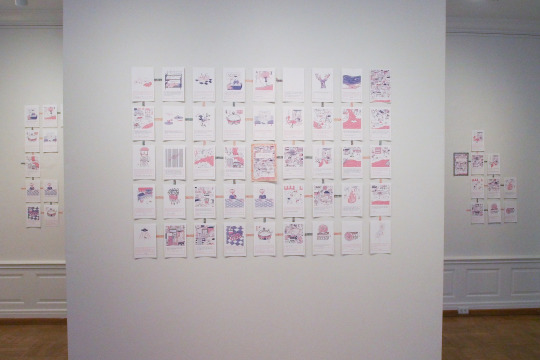
From my artist statement, because probably 2% of people actually read them when the show opened:
My project consists of a single silkscreen print of an imaginary town, accompanied by a branching-path narrative "book," which takes the form of 45 individual digital prints. The screen print features a sprawling, densely layered beach suburbia. The illustrations feature details extracted from the larger screen print, which allows the viewer to closely inspect and make sense of the cityscape. I intend for both the large print and the print series to be visually overwhelming: in the screen print's miniscule detail, and in the print series' meandering layout, inviting viewers to get lost in this fictional world. Much of my work stems from a nostalgia for the media from my childhood, particularly books, cartoons and video/computer games geared towards a young audience. This project is largely influenced by print and media from the 90s—in the textual style of gamebooks, which offer branching paths for the reader to decide on multiple possible endings, and in the visual style of 8-bit games, especially "Pokémon" and "The Oregon Trail.” There are many contemporary influences as well, including: children's television shows “Steven Universe,” “Arthur,” “The Aquabats! Super Show!” and more recently released, the role-playing computer game "Undertale," through its nostalgic 8-bit style and complex writing. Children's media in particular has a simplicity, security, and innocence that I try to emulate. There is a sense of magic in the imaginary, in creating a fantastic and dreamlike world cast in pastel colors and where animals humorously act as stand-ins for humans. My illustrations are packed with detail and a sense of playfulness, likely inspired by the Where's Waldo? books. The density sets up an interactive experience for discovery by the viewer. Everything is drawn from imagination, however, there are many obscure cultural references. This town is rooted in my ideas of Americana and kitsch: plastic lawn flamingos, unconventionally decorative buildings, tropes such as a UFO abduction, etc. There is a certain charm to what may be considered tasteless, fanciful and overdone, and I draw attention to their irony: the symbol of the lawn flamingo is exaggerated into an existence far beyond its role of suburban decoration; the impractical, decorative giant donut on the roof falls without warning; and the UFO reveals an unexpected alien form. My goal is to make art that elicits positive feelings by evoking senses of nostalgia and humor. The style and subject may be naive and childlike, but there are complexities that demand closer examination. In the print series, the writing can be absurd and non sequitur, at times shifting into a metanarrative. It asks the reader to consider ethical choices, although this rarely impacts any endings. There is tension between the 8-bit narrative text and the "cute," pleasant aesthetic of the images. None of the endings are overtly violent or gruesome; deaths are lightened, tamed, and made absurd enough to work with the overall whimsical tone. However, the writing challenges the notion that this is an idyllic utopia.
And so, that’s the concise version of what I’m about to say. I guess I’ll start by saying: I never intended to be an art major, or to seriously pursue art. I drew silly comics and made birthday cards for my friends, having always been a doodler, but I didn’t have access to any formal training. I didn’t have AP Art at my high school. I find it weird that other people do.
I started my etsy my senior year in high school and did a variety of crafts for it that were largely unsuccessful. I experimented with a lot of different mediums, but I never really got good at any one thing. I see that now as my blessing—I love learning new skills and trying to grow as much as I can. 80% of what I do is self-taught. I’m actually pretty proud of that. I’m a designer-illustrator-printmaker-zinester-publisher(working on it)-sculptor(ish)-crafter-entrepreneur. Maybe a writer? (I definitely put that on the backburner—I knew I wanted to major in English and I was really interested in creative writing, but I never got the chance to take a class in it....) I feel like to be an artist these days it’s necessary to be multi-talented. Part of it is because I’m just trying to survive as an artist. Another part of it is I genuinely love finding ways to use my creativity and imagination. Another part of it is I care about accessible/affordable art and I don’t believe that selling thousand dollar works in a high-end gallery would ever make me happy.
The past few years have been a hell of a ride. I’ve been focusing on printmaking at school, working on comics, making tiny clay dogs, etc. And it just feels really weird to think of how much I’ve grown. I can’t pretend that it feels utterly bizarre and egoistic to call myself an artist sometimes. I’ve been really lucky though, and I know that I work really hard to do what I do.
I had the ambitious idea to do a branching-path narrative zine a few months prior, but I would get stuck thinking about what sort of subject matter and setting could be compelling enough. And then suddenly it was time to decide on a project for comps as fall semester started up, and I was planning to build a 3D miniature town. I love miniatures, dioramas, cityscapes, etc. I was inspired largely by: Sean Chao, Yoskay Yamamoto’s installations, a diorama of a bunch of birds in the LA Natural History Museum I saw once (which I tried googling desperately but to no avail), fictional worlds like in Animal Crossing, The Simpsons, Arthur, and of course, Steven Universe. And yet I hadn’t built anything to that effect before, and as I was experimenting with paper buildings from templates I found online, I was realizing quickly that none of this came from any of my studio art practice or knowledge from school, and really, comps should be about what I’ve learned over the past few years, so I abandoned that idea. To build a huge diorama would require some technical practice, otherwise I’m convinced that it would have just looked like a child’s project. And as much as I am invested in children’s media, it’s frankly insulting to call my work “childish” or “naive,” two terms that kept cropping up to describe my “aesthetic.” (I mean yeah I can’t draw realistically and yeah my colors are typically pastels, but that doesn’t mean my artwork is like that of a child’s, or somehow inferior and not “real” art?)
I thought about my interests, which revolve around print culture, books, and children’s media. I had just bought a diptych risograph print by my favorite artists in Tiny Splendor, Kenny Srivijittakar, which really inspired my project as it was a weird (slightly apocalyptic?) beach cityscape (Tuff Town). So I started drawing digitally (even though that’s something I haven’t learned in school either, oh well), hoping for a huge scale project, a series of multiple giant prints that together would form a large map of sorts. Well, I spent ages trying to finish drawing just one, which was 20x30 in. so that idea got scrapped.
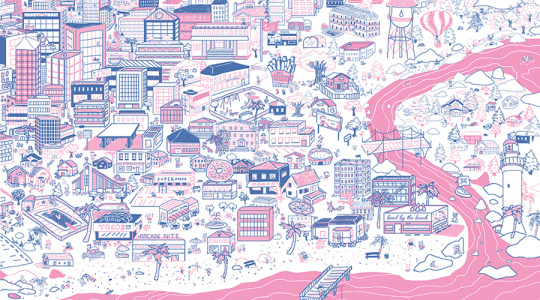
(finished digital illustration—cropped into equal sections for the book where you start in the far left center and travel to the opposite side, then up or down and back towards the left—and converted into a silkscreen print)
Then, after weeks, it was finally ready to screenprint. I figured that silkscreen printmaking would allow me to do something I learned in school. And yet it was also the biggest challenge I came across. I took silkscreen printmaking my very first semester at Oxy, three years ago, and haven’t touched it since. It was difficult, and I wasn’t happy with the work I produced then, but it was in that class that I knew I had to become an art major. And so I did. Thus, It feels significant for me to return to it, and it also made the most sense as a means to reproduce the image I had drawn digitally. Well, no matter how many hours I spent in the studio, I could not get it to print right. I won’t go into all of the horrible details, but essentially the ink was drying up as soon as I printed just one, and so I only managed to get one half-decent print, and that’s the one on display. The professors kept asking me why I chose to do printmaking when it’s a medium suited for churning out multiples, but I just physically couldn’t. They wanted me to wallpaper the room with these prints. I wasn’t really sure what that would mean, but I couldn’t do it anyway. So here we are, with probably a month or so left until the show opens, and all I have is one single print to show for myself. Even though it took ages to draw, it didn’t feel like enough (everything I do never feels like enough). So then I started working on cropping sections of the image into a book, and the rest sort of fell into place.

(also didn’t anticipate my colors being that far from what I intended)
As mentioned in my statement, I wanted to draw on the visual/textual style of early videogames, because I LOVE pixel art and I love being immersed in other worlds. I like things where everything is nice and happy, and that’s what draws me to children’s media. But I also want it to be weird and campy. When it comes down to it, everything in this project is really just a bunch of things that I like, with a lot of hidden references that probably no one except for me would get (Temmie from Undertale, The Aquabats, some bunny versions of Karamatsu fishing with a love letter as bait, etc). But I wanted this to be interactive, where viewers notice certain details and feel a connection to it. That’s my favorite kind of art, that which is accessible and relatable and makes you go like “oh! this person is a real human being who also likes this—game/TV show—I wasn’t expecting to see that type of cultural reference and humor in a piece of art.” Okay well maybe that isn’t your reaction, but that’s how I feel when I identify with something. Maybe it’s just something to do with fan culture though. Discovering that you have mutual interests. And for a lot of ~fine art~ you likely wouldn’t find that. Probably because it’s copyright infringement on some level. But anyway, it’s nice to know that artists are real people and not some edgy/misunderstood person placed on a pedestal?

(cropping from the top right corner—still laughing at Fresh Flamingo Scent and Flamingo21)
Even if it does rely on pretty obscure cultural references, the image still boils down to a pleasant little town with anthropomorphic animals walking around wearing clothes. I wanted it to be funny and silly. I’m honestly really unsure where all the existentialist writing came from, but I guess it seemed like the easiest and funniest road to go down?
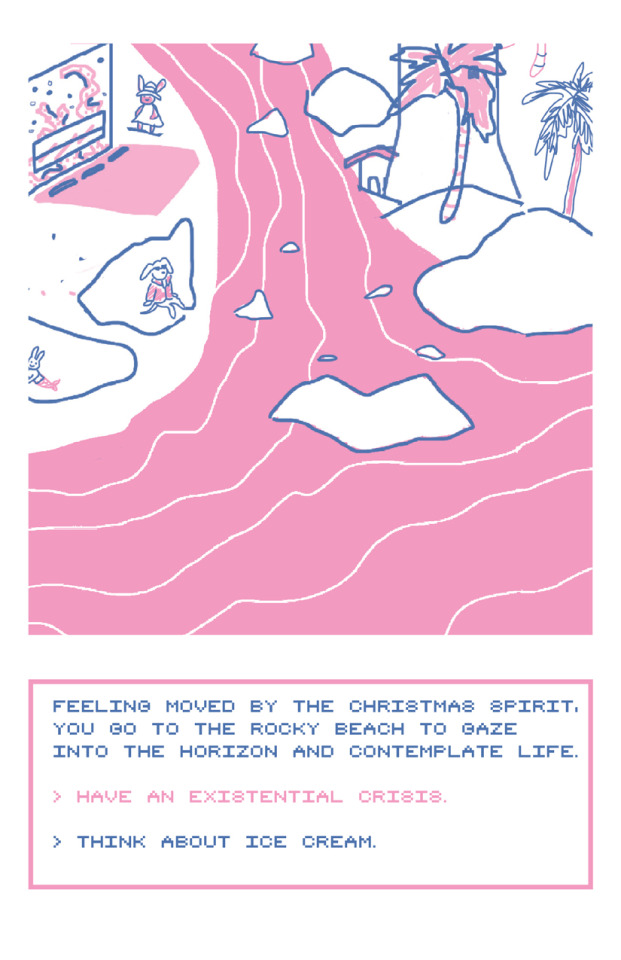
I wanted it to be a book, but I also wanted it to be displayable, for multiple people to view it at once, rather than feel like it’s a precious object that a single person had to handle at a time. This became one of the most difficult issues, the question of how to display this “book.” I thought about it for a really long time and AB came up with some complicated diagrams and mock-ups with me during a late night at the studio. I was leaning towards an accordion fold book that stretched across the wall, but the issue is that options A and B for a gamebook cannot be in a linear book sequence. Gamebooks solve that issue by relying on scrambled page numbers, but that was not suitable for displaying everything at once. Option A would go down and then there would be an entire sequence stemming from that, while option B would continue to the right and then go down, right, down, right, right, etc. It very nearly took that format, where it was either down or to the right with multiple accordion folds. My prof liked the idea of The Book as a Sculptural Object and Installation, but the book would have been impossible to close or to read, really. So I designed it to form a perfect grid, where each option branched in a particular direction indicated by arrows, and when I installed it, I connected each page with color-coordinated washi tape (with flamingos on them) so that the direction might be more obvious. A week before the show, I was still drawing new pages to fill up the missing space to create the grid, then I sent all of the files off to Catprint (my go-to printer). It ended up being 45 pages long, and granted, many of the new illustrations are pretty sloppy, but I am for the most part pretty pleased with the writing.
Then it was installation day, and a whole slew of problems arose. I didn’t know the best way to adhere them to the wall. I opted for blue tape because it was on hand, but they were falling off by next morning. I was advised to do these difficult but professional methods, or buy obscure expensive materials, or to just stick a tack in it, but I didn’t want to puncture them and I didn’t have the means nor the money nor the time to do much else, so I just bought different types of mounting squares and hoped that they wouldn’t be so strong so as to tear the paint off the walls. You’d be surprised how complicated it can be. So I had everything ready to go, and then I was told that the grid layout was a bad idea, not to mention lopsided because I eyeballed it, the washi tape was the wrong shade of color, etc. etc. I did my best to compromise with my prof who was pushing for a more immersive experience, so I installed a second set of prints to make it more installation-like and utilize the full space I had. I wasn’t really happy about it because it felt utterly redundant to have 2 sets of the same prints right next to each other, because you’d start reading when you walked in and then get to the other standalone wall and think that’s a separate piece. I kept nervously asking viewers if it made sense and if they could figure out the direction of the writing, which they could, thankfully. Or so they said.
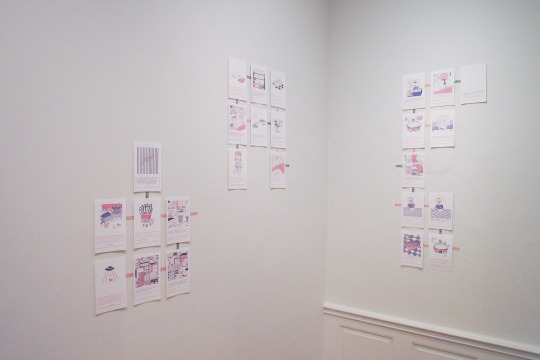
In the end, though, it worked out. The opening was lovely and many friends and strangers said incredibly nice things about my work, and they laughed and followed along and were impressed that I was able to do all of this in a short amount of time. I can’t say how much it warmed my heart to have that validation from peers and professors, and I am so thankful that my project was, for the most part, entirely my vision and what I truly love and care about, and that I got to do something so silly and personal. I’m also pretty impressed with myself that the writing came fairly naturally to me and I never spent too long getting stuck.
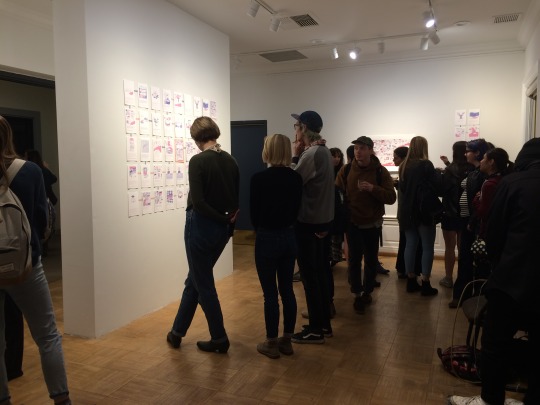
So thanks for reading this, if you actually did, and I’m not really sure anymore why I wanted to say all of this for the world to see, but I think it’ll be good for me to look back on.
Edit: the prints are finally compiled and bound into a 52 page zine with directional page numbers. Snag a copy from me in person, on my etsy, or my new shop for my new PRESS. I can’t stop thinking about the projects I want to do and zines I want to publish but alas I must first finish school. Honestly, it’s my pipe dream to be able to run and live off my own publishing press, making books and prints for myself and other people. In the meantime though if anyone knows who will hire me for design/publishing/illustration/etc... :^)
*EDIT: I’ve had to replace every instance of the words “choose your own adventure” with “gamebook” and “branching path narrative” because of intellectual property infringement, including replacing the covers for the latest edition... you live and ya learn
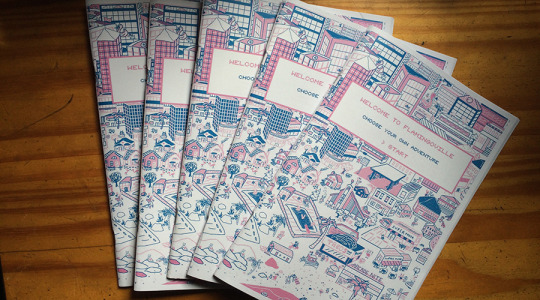
1 note
·
View note